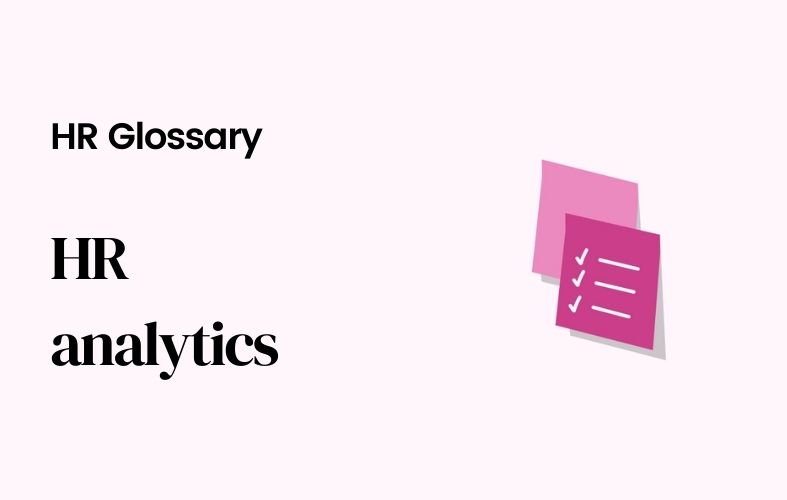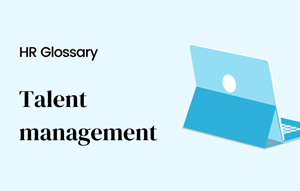HR Analytics

[Sommaire]
What is HR analytics?
HR analytics is the use of people data to improve organizational performance and solve business problems. By analyzing and seeking to understand the way in which people are behaving, you can start to address the drivers of certain situations. It is also referred to as people analytics and workforce analytics.
It uses people data such as payroll, absence levels, and FTE in combination with business information such as sales figures or profitability.
5 HR analytics most common terms
Human resource analytics is the measurement, management, and analysis of people-related data to drive better decision-making in HR. It covers a wide range of topics, from employee retention to succession planning.
The following are five workforce analytics terms that are commonly used :
1. Data mining :
Predictive HR analytics relies on a large volume of data, which must be carefully analyzed to identify patterns and trends. Data mining is the process of extracting useful information from this data using sophisticated analytical techniques.
2. Machine learning :
Machine learning is a branch of artificial intelligence that allows computers to learn from data without being explicitly programmed. Machine learning algorithms are often used in human resource management to identify patterns in data automatically.
3. Predictive analytics :
Predictive analytics uses historical data to predict future events. In HR, predictive analytics can be used to forecast things such as employee turnover, HR costs, or the impact of different HR policies.
4. HR Metrics :
HR metrics are a set of quantifiable measures that help HR managers understand how their decisions and actions are impacting organizational performance. HR analytics uses a wide range of data collected metrics to gain insights into HR processes and programs, like :
- Attrition rate : The attrition rate refers to the number of employees who leave an organization or department over a given period of time. Talent analytics can help HR managers identify patterns in employee exits, which can be used to inform HR strategies for increasing retention and engagement.
- Employee engagement : Refers to the level of commitment and connection that employees feel toward their organization. Relevant data can be used to measure employee engagement and identify factors that impact engagement levels.
- Employee turnover : Refers to the rate at which employees leave a company voluntarily or involuntarily. Gathering data can help HR managers understand employee retention rates, which can, in turn, inform HR strategy for improving retention and reducing costly turnover rates.
- Cost to hire : Refers to the total cost of bringing on a new employee, including HR recruitment costs, onboarding, and training expenses, and lost productivity during the hiring process. It can help HR managers understand these costs in order to identify opportunities for reducing costs and maximizing efficiency in HR processes.
5. Cost modeling :
Cost modeling is a technique used to estimate the cost of different HR policies or programs. It can be used to compare the cost-effectiveness of different HR options and make more informed decisions about HR spending.
What are the pros of HR analytics?
Good HR analytics management is a powerful tool that can be easily overlooked in the day-to-day running of an organization. It helps leaders make fact-based decisions that can improve the way their organization operates. Some of the best examples include :
Increased staff retention:
It allows organizations to get into the detail of retention figures. And with this information, you can take steps to improve retention by focusing on elements that need improvement.
It can also highlight employees that are showing signs of leaving – giving you an opportunity to do what you can to keep that individual.
Improved employee skills:
By using your HR analytics to review the skills within your organization, you can quickly identify what you need to do to fill knowledge gaps. And by analyzing your employees’ backgrounds, you can judge which employees may be better suited to training in order to fill those knowledge gaps.
This benefits you in two ways – it helps create personalized learning and development plans for your employees, a key element in employee retention, and it will help you fill strategic skills gaps for future growth.
Improved financial insights:
HR analytics can help you identify ways to cut costs without damaging your business or affecting the employee experience.
By using data such as cost to hire and analyzing the benefits packages you offer to employees, you can quickly identify opportunities to reduce costs.
By monitoring HR data such as turnover, you can see how changes to HR processes impact employee satisfaction, giving you a better understanding of your HR decisions and their financial costs.
What are the cons of implementing HR analytics?
Reactive rather than proactive
Teams can become so focused on analyzing data that they forget to actually act on it. This can lead to a ‘reactive’ rather than ‘proactive’ HR strategy, which is not effective in the long term.
Data overload
It is important to remember that data is only useful if it is used effectively. If teams are overloaded with data, they can quickly become bogged down and miss the important insights that could be gleaned from it.
Lack of ownership
Another common issue with HR analytics is a lack of ownership. Because it relies on data from different departments within an organization, it can be difficult to allocate responsibility for HR analytics to one team or individual.
This can lead to a lack of focus and direction, which can impact the quality of insights generated.
What are the best practices to implement HR analytics?
HR data analytics may be powerful, but that does not mean it is easy to implement. Some HR departments have historically been seen as departments focused on qualitative data.
For this reason, a shift into quantitative data and analytics can feel like a challenge. To implement it successfully, there are several best practices to follow :
1. Define what data is important to track
The first step is to define what data is important to track in order to achieve your HR goals. This will vary from organization to organization, but some examples include:
- Employee retention rates
- Employee engagement levels
- The cost of hiring
- The cost of employee benefits
- Turnover rates
2. Put systems and processes in place to collect that data
Once you know what data you need to track, you need to put systems and processes in place to actually collect it. This may involve using HR software to automate data collection, or it may require manual data entry.
3. Analyze the data to glean insights
The next step is to actually analyze the data to glean insights that can inform your HR strategy. This requires understanding how to use data analysis tools, as well as having a strong understanding of HR metrics.
4. Use those insights to inform HR strategy
Once you have your data and insights, it is time to start using them to inform your HR strategy. This may involve making changes to your recruitment process or implementing new employee retention programs.
5. Rinse and repeat
The final best practice is to rinse and repeat the cycle of data collection, analysis, and strategy implementation.
By constantly tracking HR data, you can ensure that your HR strategy is always up-to-date and informed by the latest insights.
To sum up
Overall, implementing HR data analytics can be a powerful way for organizations to gain insight into HR decisions, improve employee productivity and satisfaction, and drive the growth of business outcomes.


